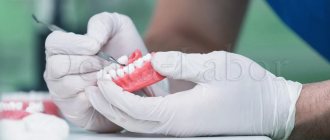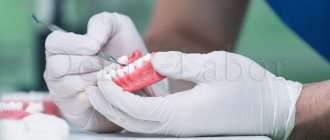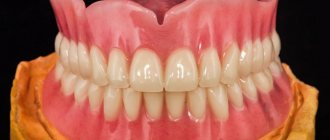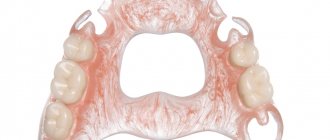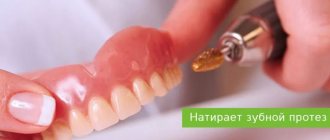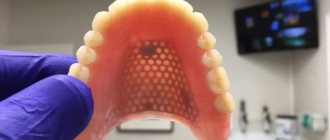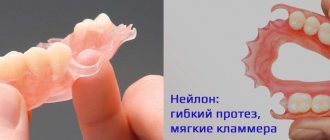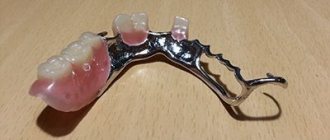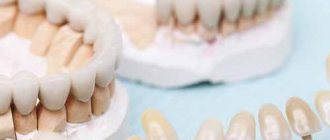For people who use dentures, the most important factor is the quality of their attachment in the oral cavity. Obviously, sliding, falling out structures cause terrible discomfort. This is a major problem for patients and a challenge for dentists. In this article you will learn how dentures are attached and what determines the quality of their attachment.
There are many factors that influence how dentures fit. Firstly, the anatomical features of the patient’s oral cavity.
- Position, tongue mobility
- Load distribution on the bed
- Interaction of the device with the organs of the oral cavity
- Position of teeth and bite
Fixation methods are divided into direct fastening elements and additional elements.
Cover structures – what are they?
In the classical sense, overdentures are removable appliances that get their name from the word “overdenture,” which literally means “overdenture” in English. That is, they usually cover, or more precisely, rest on the teeth and roots preserved in the mouth, or installed implants. In this case, the term “covering” is considered most appropriate.
Overdentures are removable appliances
However, today this is the name given to any removable systems. Even those that rest solely on the gums, when there are no teeth at all in the mouth. Experts justify this by the fact that in this case the structures are also covered, only not by implants and teeth, but by gums.
A dental overdenture can fill just one defect, can be partial (for partial and multiple edentia) or complete, when it is necessary to restore all the teeth on one/several jaws.
Now let’s look in more detail at what methods of fixing covering systems in the oral cavity exist.
Removable dentures made of nylon
A base made of thin, elastic nylon on which artificial dental crowns are attached. Products are manufactured based on the clinical situation.
- The bioinert material does not contain metal impurities and does not cause allergies
, so the structures are not removed at night. - Since the color of the base is matched to the natural shade of the gums, the design is not noticeable and looks natural
.
Among the advantages are price, speed of adaptation, convenience. The only drawback of the design is that soft nylon sags and becomes deformed. But even so, the service life is 5-8 years
.
Method number 1: on the gums and palate
The most common and budget option is overdentures, which are held in the mouth using the suction effect on the mucous membrane, palate and gums. These are completely removable structures that are installed when there are no teeth at all. They are very massive, have a palatal overlap in the upper jaw and a large base if it is necessary to restore teeth in the lower jaw.
The bulky base of such devices helps to increase the area of contact with the mucous membrane, because without this they simply will not be able to stay in the oral cavity. However, the base of the structures also becomes the main reason why patients experience discomfort. The base covers the gums, rubs them, causes attacks of nausea and increased salivation, interferes with full conversation and the taste of your favorite dishes, and small pieces of food get stuck under it.
Such dentures are fixed on the gums and palate
There is a large selection of similar structures: acrylic, nylon, silicone, from monomer-free materials of Italian quality (Quattro Ti) and acrylic resins (Acry-Free). Each type of device has its own advantages, but they are all united by a big drawback, which is most clearly manifested in patients who choose covering dentures in the absence of teeth. Bone tissue atrophy occurs under the structures, which is why they gradually begin to fit poorly to the gums and fall out of the mouth without the use of glue or additional corrections by an orthopedic dentist.
Implants
Strong fixation occurs due to the fact that they are installed as artificial analogues of living roots. Removable structures can be attached to implants and can be removed at home.
The best and most popular of those offered are implants and telescopic crowns. But for each patient they are selected individually by a highly qualified orthopedic dentist.
Due to the fact that the oral cavity is constantly mobile, displacement or loss of the structure often occurs. Therefore, there are additional means of fixation.
Method No. 2: on the patient’s natural teeth
A modern overdenture can be more securely fixed in the mouth if there are supporting teeth or preserved roots. This fastening option is possible to improve the fixation of removable appliances even if there are extensive defects1 in the dentition, and when only a few elements have been preserved that can become supporting ones. There are several mounting options available here.
A tooth-retained overdenture is also removable, but it is lighter and more compact than a design that is retained solely on the gums. It has a reduced palatal overlap, and sometimes there is no such overlap at all (for example, in sandwich dentures), which allows the patient to feel the taste of the food consumed. However, such devices contribute to rapid wear and destruction of the supporting elements of the row, because during operation they bear a serious load.
On clasps
Such overdentures are attached to the mouth using special hooks that tightly grip the supporting elements of the row. This is one of the most financially accessible, but not always convenient and aesthetic varieties. After all, hooks can be noticeable in the smile area. In addition, clasps can become loose and fail, which ultimately leads to instability of the entire system, displacement of the devices, and physical and psychological discomfort.
The photo shows a prosthesis with clasps
“I had to remove a couple of teeth. After that, for several weeks I agonized over the best way to restore them - with bridges or implants. I can’t decide on either one or the other... And money is still tight. And so my doctor advised me to temporarily install the covering apparatus on hooks, saying that it was inexpensive and there was no need to sharpen my teeth for it. I agreed on the condition that while I was wearing it, I would calmly make a choice and save money for a normal treatment option.”
LenaElena, review from 32top.ru
On attachments or clasps
One part of the fastening is installed in the abutment tooth or root, and the second is installed in the base of the removable product - the two elements are simply combined and snapped into place. This method of fixation significantly increases the stability of the structure and also improves its performance characteristics. The overdenture with clasps is compact and lightweight. The patient no longer has to take it out of his mouth every day. However, the price for it is much higher than for a product with hooks.
This is what a prosthesis with clasps looks like
Teeth cannot be used as support if they are severely damaged or inflamed, have cysts and granulomas on the roots, or are loose due to periodontitis and periodontal disease. They must first be cured, if, of course, they are treatable. In the latter case, that is, with periodontal diseases, the doctor can offer the patient a special splinting structure (clasp devices) with hooks that tightly grasp each loose element of the row.
Using telescopic crowns
When doctors offer patients overdentures attached to telescopic crowns, not everyone understands what it is. The design of such devices provides for the presence of several hollow crowns that are fixed to the supporting elements of a row, previously covered, again, with artificial crowns.
The photo shows a prosthesis on telescopic crowns
The connection of all components of the system into a single whole occurs according to the telescopic principle, when one crown is made slightly smaller in diameter than the other. As a result, the two fastening elements fit tightly onto each other, which ensures high quality fixation. The price of such products is quite high, because their production involves painstaking work and a high level of professionalism of the doctors who perform it.
Manufacturing and installation of a prosthesis
Includes stages:
- Preparatory and diagnostic – after hygienic cleaning, treatment, the patient undergoes a survey x-ray, CT scan of the jaw, which requires prosthetics.
- The dentist takes an impression and sends it to a dental laboratory.
- The production of an orthopedic system lasts on average 2 weeks. New technologies for taking impressions and 3D modeling make it possible to create anatomically verified structures that reproduce the chewing surface of each element down to the smallest detail.
- The doctor tries on the finished denture for the patient and corrects any discrepancies.
The final stage is fixation of the product in the oral cavity.
Method No. 3: fixation of removable covering systems on implants
Removable overdenture on implants - what is it? This is when, instead of gums or roots of living teeth, artificial metal roots (made of titanium) act as support for the structure, which are implanted into the bone tissue of the jaw.
In this case, implants help improve the quality of fixation of removable devices, which makes the process of their use more comfortable. This option is a kind of intermediate link between completely removable systems (we talked about them earlier) and completely non-removable ones (be sure to read about them further).
If a patient wants to improve the stability of removable overdentures, doctors first install artificial roots into the bone tissue. That is, implants. The minimum is 2-4 pieces (the more, the more reliable, of course). Sometimes mini-implants are used as this option. But this method can only be considered on a temporary basis - such structures cannot withstand the load.
How dentures are attached to implants in this version will be discussed below.
On ball-shaped abutments
Abutments, which are placed on top of the implants, are connected to each other and combine the implant and prosthesis into a single system. In this case, spherical abutments are used for fixation, resembling a ball in appearance. Corresponding holes are created for them in the recess of the prosthesis.
This is what a prosthesis on ball-shaped abutments looks like
This is the most affordable option in terms of finance, but not the most comfortable. The internal fastening elements inside the prosthesis wear out, stretch and break, so they periodically need to be replaced with new ones.
In addition, the system does not distribute the chewing load well. This fastening is used both when installing full-fledged implants and mini-models. In the latter case, the abutments form a single whole with the body of the implant (one-piece structures).
Experienced doctors advise considering this method of attachment only as a temporary measure, especially when choosing mini-implants. It is suitable for those patients who want to increase the stability of removable structures in the oral cavity. But you shouldn’t count on the fact that with such devices you will eat without restrictions.
On Locator type equatorial abutments
If the covering dental prosthesis is fixed on equatorial abutments, then this is much better than when it is fixed on spherical fastening elements. The Locator system is distinguished by a solid cylindrical shape, which contributes to a more even distribution of the chewing load, prevents rapid breakage of the abutments, and increases the level of comfort.
The Locator system features a solid cylindrical shape
On a strong metal beam
Implants in the amount of 2-4 pieces are implanted into the jawbone, and a metal beam is installed on top, connecting them to each other. Next, a removable structure is snapped onto the beam, the base of which has special holes. If necessary, the patient can detach and attach the denture, but the bar will always remain in the mouth.
This option is more comfortable and durable than those listed earlier. But its cost is quite high, which is why modern patients prefer to choose more advanced methods of dental restoration, which today are almost equal in price. Namely, fixed prosthetics also supported by implants.
The prosthesis can be fixed on a metal beam
It is interesting that fixed dentures also have a beam fastening system. But, unlike removable ones, such a beam is more reliable, is created individually and remains inside the prosthesis, that is, it forms a single whole with it. Such a system is, of course, more reliable.
Additional means of fixing dentures
Additional means include special compounds that help to hold removable structures due to their properties - viscosity and adhesiveness. You can buy them at any pharmacy. They are indispensable when devices are at the very beginning of use and can cause some discomfort, as well as over time, after several years of active use, when the fastening system gradually weakens. How can you additionally secure a denture:
Fixing adhesives, creams and gels
They are presented in a wide range on the market. Their composition is approximately the same, the adhesion of the surfaces occurs due to the action of polymers that glue them together. There are well-known products to choose from: Corega, Rox, Fittident, Protefix and others. They can be used to fix a complete removable denture, both lower and upper, as well as partial, on the gums. If the device falls out of your mouth, glue or cream will help to quickly secure it.
Which of these is better for fixing dentures depends on the doctor’s recommendations in a particular case, the presence or absence of allergies, the condition of the oral cavity, and personal preferences.
Which cream is best suited for each specific situation, read the article on the website “Review of the best creams for fixing dentures: features of composition and application.”
Special prosthetic pads
They are available for lower and upper removable devices. Made of special fiber in the shape of an arc on the gums or plates on the palate. They serve as a layer between the structure and the gum, providing stability. Their function is to protect the mucous membrane from chafing when getting used to the devices, and to securely hold it.
Read more about this product in the material “Why do you need spacers for dentures: application features and a review of popular brands.”
Special stripes
They are similar to gaskets, but are used if there are bite pathologies. They are coated with an adhesive composition, which must be heated in warm water before use. The warm strip is glued to the denture and inserted into the mouth along with it. This remedy protects the mucous membrane from displacement of the apparatus and the occurrence of inflammation, and if it occurs, it reduces pain and promotes tissue healing.
Powder products
Also an adhesive composition, but in powder form. It is necessary for those patients who have insufficient salivation. The powder “seizes” in the mouth and holds the structure well. True, it is more difficult to distribute evenly than paste-like products.
Which of these fixes dentures better depends on the patient’s situation, at what period of wearing he turned to the help of these products, as well as what is the situation in the oral cavity, whether there are inflammations, wounds, etc.
Fixed dentures on implants are the best alternative to removable overlays
If we consider under the term “overlay” all structures that rely on something (gums, teeth, implants), then we should also talk about fixed dentures on implants. But they should be discussed separately, and it is important to understand the differences in such systems.
Firstly, unlike all the previously listed varieties, the patient will not be able to remove them from his mouth on his own. But a doctor can easily cope with this task if the need arises, for example, to clean, repair and correct structures (they are secured with special screws). Secondly, removable and non-removable devices based on implants are a big difference. Fixed ones differ greatly in a number of indicators:
- implantation methods and artificial root models used: today, it is possible to completely restore teeth on one or both jaws using one-stage treatment protocols, allowing you to install a fixed denture in less than a week. Depending on the situation, the patient may be offered treatment with 3, 4, 6 and 12-14 classic (or in combination with elongated zygomatic) implant models according to the all-on-3, all-on-4, all-on-6 protocols. basal complex,
- methods of fixation in the oral cavity: the most common option is with special small screws, which are screwed through the coronal part and firmly connect the implant with the prosthesis into a single whole, and are skillfully masked with a composite on top. If necessary, the doctor can easily remove the screws and pull out the product, and then fix it again. The second mounting option is using dental cement,
- level of comfort: fixed prosthetic structures are much more aesthetic, comfortable and compact. They do not cause difficulties during the period of adaptation and do not interfere with diction. They have no palatal overlap at all, but at the same time they have a small and elegant gingival margin (if the patient restores all teeth), which eliminates the need for mucosal plastic surgery and masks all defects of the natural gum, if any. In addition, inside such devices there is a durable metal base that stabilizes artificial roots and allows you to begin fully chewing food already during the rehabilitation period, that is, immediately
- durability: if removable covering structures and mini-implants themselves need to be replaced after 3-5 years, then classic models of artificial roots can be used until the end of life, and permanent non-removable products last 10-15 years or more.
The photo shows the all-on-4 implantation scheme
When is the use of additional funds justified?
People who wear pullers do not always have confidence that the devices are well fixed and will not fail at the most inopportune moment. Therefore, additional means of fixation are used quite widely. They also have a number of functions:
- at the beginning of wearing they help to adapt to artificial structures in the oral cavity, accelerating addiction,
- prevent particles of food, liquids and air from getting under the prosthesis, ensuring tightness,
- protect the mucous membrane from mechanical irritation, rubbing and subsequent inflammation due to the content of anti-inflammatory components,
- when using products with refreshing ingredients (not all have them), they give freshness to your breath,
- prevent the structures from moving and falling out during long-term use if the position of the gums changes.
However, it is important to remember that additional means of fixation in case of long-term use of the structure do not replace a trip to an orthopedist for its relocation, repair or replacement with a new one. Their use is justified with high-quality structures for additional stability in the oral cavity.
1Samusenkov V.O. [and others] Rational approaches to prosthetic treatment of patients with diseases of the oral mucosa / Dentistry for everyone. – 2014. 2Zholudev S.E. Features of prosthetics with complete removable dentures and adaptation to them in elderly and senile people / Ural Medical Journal. – 2012.
Author: Dulgarov Zh. G. (Thank you for your help in writing the article and the information provided)
About the advantages and disadvantages of different types of fastening
Will a removable overdenture be comfortable? As you can see, it depends on various factors. If it rests only on the gums and palate, then there will be little comfort; on the contrary, even the best models will soon begin to fall out of the mouth, put pressure on the mucous membrane, and interfere with diction and the perception of the taste of food. However, this option is the most budget-friendly, which forces patients to choose it.
If the structure is fixed on the patient’s own teeth, then this is a more successful, reliable, aesthetic and comfortable option. Such a system will no longer fall out of your mouth at the most inopportune moment, and for greater reliability it will not have to be treated with various adhesives such as Coregi. But here it is very important to understand that the service life of the system will directly depend on the condition of the natural “supports”, and under double load they can quickly fail, collapse and become loose. It often happens that after wearing coverings, the supporting teeth have to be removed, since they cannot be restored.
For better fixation of the prosthesis, you can use special creams
When choosing to fix removable systems on implants, the patient receives fairly compact structures that fit securely in the mouth, almost do not overlap the palate, and do not put pressure on the gums. These are easy to adapt to and get used to, but their service life is very short-lived, because the same spherical abutments quickly fail, and mini-implants cannot take on the full chewing load and need to be replaced every 3-4 years.
If you choose a beam fastening system for removable overdentures, then the price for restoring teeth here will be slightly less than when installing full-fledged fixed dentures on classic-length implants. The difference in cost is insignificant, but the quality, aesthetics and level of comfort are very different, so experts believe that it is better to consider fixed prosthetics on implants.
Notice
: Undefined variable: post_id in
/home/c/ch75405/public_html/wp-content/themes/UltraSmile/single-item.php
on line
45 Notice
: Undefined variable: full in
/home/c/ch75405/public_html/wp-content /themes/UltraSmile/single-item.php
on line
46
Rate this article:
( 2 ratings, average: 5.00 out of 5)
implantation
- Dembitsky A.V., Kulginsky E.A. On the advisability of using overdentures in the complex treatment of extensive dental defects // World of Medicine and Biology. – 2011.
Expert “Many patients confuse removable dentures on implants, fixed on a bar, with fixed ones. Although these are two fundamentally different options both in price and in terms of comfort. In removable structures, the beam only plays the role of a retainer. In non-removable ones, it is part of the system and is a strong and integral basis of the prosthesis, stabilizing the implants and allowing the patient, already during the rehabilitation period, that is, immediately after the installation of artificial roots, to fully chew food and eat their favorite dishes.” Implant surgeon, ch.l.h. Bespalov Roman Dmitrievich
Consulting specialist
Bespalov Roman Dmitrievich
Specialization: Implant surgeon, Ph.D. Experience: 26 years
Immediate dentures
Removable immediate dentures - to replace defects in the dentition during the production of a permanent orthopedic system. There are three types of such models - full, partial, butterfly.
They cope with the task, return partial work to a lost dental unit and hide a visual defect. The disadvantages include fragility, fragility, and long addiction.
Comments
What materials are such a prosthesis made of?
Makarova O.A. (08/21/2020 at 10:17 pm) Reply to comment
- The artificial base and gingival edge of the prosthesis are usually made of acrylic, but they are also made of nylon, silicone, polyurethane, and non-monomer acrylic resins. Fastening elements can be made from the base material that makes up the base of the prosthesis, but for strength and greater wear resistance they are often made from medical metal alloys. As for artificial teeth, they are made of plastic, metal-plastic, ceramic and metal-ceramic, and zirconium dioxide. That is, the choice is very wide and actually depends primarily on the type of prosthesis you choose (removable or implant-supported).
Editorial staff of the portal UltraSmile.ru (08/23/2020 at 12:21 pm) Reply to comment
Thanks for such a wonderful article. Tell me, what do you think, with very problematic and regularly inflamed gums, which option should you pay attention to first? The area for prosthetics is large, but I don’t want removable dentures.
Marina A. (09.23.2020 at 09:18) Reply to comment
Please tell me, my mother wants to install such a prosthesis, but I have heard that they are not reliable, they can fly out and wobble. In this case, there will be severe discomfort, is that true?
Elena (09/23/2020 at 01:01 pm) Reply to comment
And I heard that fixing dentures with cream, firstly, is not very reliable, and secondly, with prolonged use it can be dangerous. What creams should I use to ensure safety?
Victor (09/23/2020 at 01:07 pm) Reply to comment
If a removable denture was installed not so long ago, you are wondering how it is fixed, what is the covering structure? How much will it cost to fix removable covering systems on implants?
Oleg (09.23.2020 at 14:30) Reply to comment
Dentures were placed on the upper jaw. It took me a long time to get used to it, they pressed and rubbed. The gums were inflamed. I went many times for correction. Probably in a couple of months I began to wear them fully, but they began to fall off while eating. My dentist recommended Mostaden Twins Tech cream to me. It easily attaches to wet dentures. Does not change the taste of food and drinks. There is a pleasant mint taste in the mouth. Has a secure hold for up to 12 hours. Prevents food from penetrating under the denture. I began to fully wear the prosthesis without fear that it would fall out while eating or while talking.
Alice (10/21/2020 at 11:34 am) Reply to comment
Good afternoon Can you please tell me how long it will take to install dentures on my natural teeth? Is there any alternative while the prosthesis is being manufactured? Thanks in advance for your answer.
Sasha (11/20/2020 at 6:29 pm) Reply to comment
Of course, you can fix any prosthesis in your mouth. Both the lower and upper parts. But if you had surgery or had a bone cut off, then the prosthesis may not fit on such gums. Not every specialist will undertake such work.
Alina (11/20/2020 at 08:22 pm) Reply to comment
It’s good that now there are so many ways and options. But which one is the most reliable, which is recommended in most cases? Or will it all be purely individual?
Olga (11/20/2020 at 08:29 pm) Reply to comment
After reading the article, several questions arose. 1) How long do removable and fixed implants last? Which ones are more durable? 2) Is it difficult to care for them and maintain an aesthetic appearance?
Artyom (11/20/2020 at 09:04 pm) Reply to comment
Of course, implants are better because they will last better. And so my mother used Corega cream. Helped a little, but not much. She has the most ordinary prosthetics. Although I already made the second one 15 years later. The gums sank, so the first ones no longer held up.
Peter (11/20/2020 at 9:16 pm) Reply to comment
Write your comment Cancel reply
Troubleshooting methods
The list of techniques used to ensure the seating density of the replacement structure includes:
- Adjustment of configuration and replacement of fixing elements;
- Use of adhesives;
- Implantation of mini-implants;
- Complete replacement of the prosthesis.
In some cases, it is possible to avoid adjusting the prosthesis - to do this, it is necessary to teach the patient how to control the masticatory muscles. Proper biting and chewing of food ensures even distribution of the load, which eliminates the possibility of displacement of the replacement structure.
Stock
-27%
Teeth in 1 day on Straumann implants using ProArch technology!
300,000 rub. 220,000 rub.
get -9 %
BASAL COMPLEX - Restoration of teeth on 1 jaw in 3 days 330,000 rub.
300,000 rub.
get -17 %
Quadrotti dentures (without palate) 60,000 rub.
50,000 rub.
get -50 %
Treatment of stomatitis for the promotion of 10,000 rubles.
5000 rub. get

